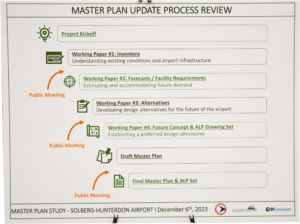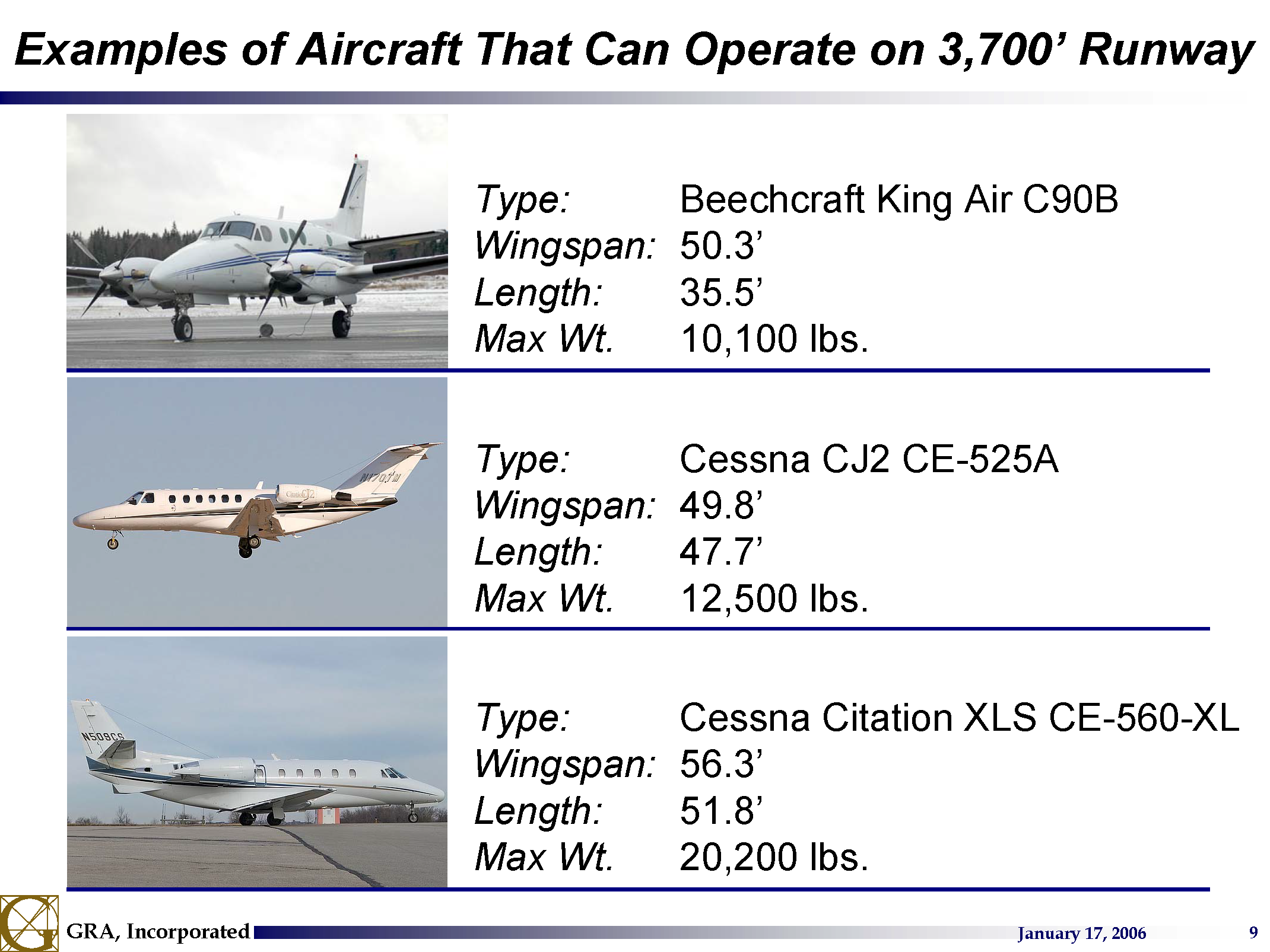The status of Solberg-Hunterdon Airport’s facilities and plan tend to be step-wise changes over time. This page will attempt to track the facilities along the steps as best they can be understood. We expect to offer frequent updates so check back to see what may have recently changed. Two things we use to mark the status are the 1997 Master Plan and Airport Layout Plan (ALP). Full copies are available for download in the “1997” tab below.

The Public Information Meeting #1 on December 6, 2023 provided little information of value to the public. The meeting did offer an introduction to DY Consultants, a Manhattan based international aviation planning firm, working under State contract; a Grant from the NJ-DOT #6422325 to develop the Solberg Master Plan Update. The update process was briefly reviewed per the chart indicating that there are windows for two or three more Public Information Meetings. According to the presenter from DY Consultants they were at the point of “gathering inventory information”, theoretically in preparation for preparing a Working Paper #1 on Inventory. Will there be another information meeting, as indicated, to present the inventory?
Beyond that, the public remains in the dark with regard to the airport owners plans. We can only speculate that the 2024 expansion will be at least of the magnitude documented in the 1997 Solberg Master Plan. You will find links to download both the full version January 1997 Master Plan and the September 1997 ALP in the 1997 tab.
Update available soon, please check back.
Solberg-Hunterdon Airport was awarded a NJ DOT Airport Improvement Grant of $684,290.75 for paving of the final 735 x 50 ft. turf section (formerly displaced threshold 04) of the main runway 04-22 along with lighting and paint striping. Readington Township Planning Board approval was granted in 2021 with work commencing shortly thereafter but not completed until 2022. Because upgrades proposed in the 1997 Master Plan were never implemented the airport configuration is unchanged.
Airport Configuration Based On Existing Facilities

The above aircraft examples are from a 2006 report commissioned by Readington Township. It is noteworthy that other deficiencies of facilities at Solberg-Hunterdon Airport, cited in the “NJ Plan” section of this page, could preclude safe operation of these or other similar aircraft at the airport.
Readington Township was notified in April 1999, via letter (link below), that the 1997 Solberg-Hunterdon Airport Master Plan and Airport Layout Plan (ALP) were Conditionally Approved, pending an Environmental Assessment and incorporating a reduction in the main runway’s length.
- Solberg-Hunterdon Airport January 1997 Draft Master Plan
- Solberg-Hunterdon Airport September 1997 Airport Layout Plan (ALP)
- NJ DOT Letter of Conditional Approval, April 8, 1999 (amended Sept 1997 4,890 x 100 ft. runway)
Airport Configuration Before 1997 Master Plan (ALP page 2 of 13)
Within New Jersey’s Department of Transportation (NJDOT) the Bureau of Aeronautics has general oversight responsibility of the forty-one Public Use Airports and numerous other restricted use aviation facilities. They also facilitate distribution of aviation grant information and applications for the NJDOT. The current Solberg-Hunterdon Airport Master Plan update is funded by NJDOT under grant #6422325.
The Bureau of Aeronautics also coordinates information related to the New Jersey State Airport Systems Plan (SASP), the most recent version being completed 2007, making it somewhat dated.

A summary of the 2007 SASP takes a very aggressive position with regard to expanding Solberg-Hunterdon Airport as documented in the 1997 Master Plan. Specifically, page 10 includes Solberg among “…several system airports [which] should be upgraded to meet facility and service objectives identified for Priority General airports.” Reconciling this statement with deficiencies identified in the 2007 full version of the SASP yields Solberg is not compliant with the runway width (100 ft. or greater), runway strength (30,000 lb. or more) and Runway Safety Area (RSA) runway/taxiway separation compatible to the Airport Reference Code (ARC), B-II for Solberg per the 1997 Master Plan. Currently the primary runway width, including 2021-22 pavement extension of 735 ft. is 5o ft., runway strength is believed to be under 12,500 lbs. as no strengthening work has been done and a “Small Only” designation was appended to the prior ARC. Finally, runway/taxiway separation is at 200 ft., center to center, with aircraft tiedowns reducing that effective width. Specifically absent from the list of deficiencies is RUNWAY LENGTH with Solberg falling short of the 4,000 ft. minimum for Priority General airports. It was not until 2021-22 that Solberg paved the main runway to 3,735 ft., satisfying the minimum length for a General Services airport, 3,500 ft.
The reality is that today, Solberg-Hunterdon Airport is only a General Services airport, not the Priority General Services or Advanced Services airport the state would like it to be. It is reasonable to believe that the State is focused on Solberg expansions that would upgrade its status based on a High “Development Potential” documented in the full version of the SASP. Although unstated, it would be reasonable to equate this potential to the large amount of land adjacent to the airport and unavailable at any other existing airport.

The 2022 SASP summary continues to maintain an aggressive position with regard to upgrading airport status, stating on page 6, “Priority General Service (PGS) airports are general aviation airports that contribute significantly to the airport system and should ideally be upgraded to Advanced Service, but have constraints that make expansion at these airports unlikely or unfeasible. For those airports included in the Priority General Service functional level, minimum facility and service objectives have been identified. The SASP recommends that any airport included in the Priority General Service functional level be developed to the fullest extent possible in efforts to comply with the Advanced Service functional level objectives. Where meeting the Advanced Service facility
and service objectives is impossible or unfeasible, the minimum facility and service objectives of the Priority General Service airport functional level should be applied. The services at PGS airports may include fuel sales, aircraft rental, and pilot training.”
Interesting, is the discussion in the full version of the SASP of geographic areas where advanced services are lacking. Coverage Area Void 5, on page 7-41, acknowledges, “Each of the airports identified as options for improving Advanced Service coverage in this area are constrained by factors that would impact their ability to be expanded…” To address this, one considered option is construction of a new airport, but, a “clean-slate analysis does not indicate that additional airport facilities are needed in this area of the State.” Now recalling this analysis is from 2007, and Solberg has, in fact, suffered a decline since that time, a reasonable person is likely to deduce that an argument to expand Solberg-Hunterdon Airport is not a NEED but a WANT!
The Economic Impact of Solberg airport from 2016 is available from the Bureau of Aeronautics website and documents a Low level impact, agreeing with findings cited in the 1997 Master Plan. This fact alone is alarming because the community that surrounds the airport would suffer dramatic decreases in property value, a high level adverse economic impact, should Solberg airport expand to accommodate the business jet traffic anticipated from the 1997 Master Plan.
In the end, this plan is created and developed by aviation/airport advocates. Any outcome other than expansion would go against their interests.